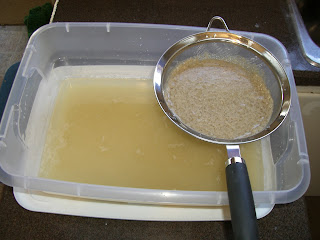laundry soap, surface cleaner, toilets, soap scum, floors, pets, jewelery, seriously everything...
The first I ever heard of Sop Nuts was in 2009 at a small business expo. They weren't in their raw form but there were two companies using them as the active surfactant in their products. What is this Soap Nut? Turns out that yeah, it's a nut, actually a nutshell, Sapindus Mukorossi. The shell has a thick coating on the inside. When you boil them in water they create a natural surfactant. (
surface-active agent: a substance, such as a detergent, that can reduce the surface tension of a liquid and thus allow it to foam and penetrate solids; a wetting agent). Hence the secret ingredient in a certain company's top secret ingestable ingredient which 'Makes Water Wetter'. There it is, mystery revealed, just buy the nuts. This 1kg bag could do 500 loads of laundry or clean enough countertops to wrap around earth, maybe even twice. The point is it'll last a long, long time. Even better, you won't have to use chemical detergents and cleaners. You don't even have to sacrifice efficacy. I've been trying them for almost a year (same bag) on all kinds of cleaning and the only thing I've found that it isn't great on is glass.
Making All-Purpose Concentrate: Boil 14 soap nuts in 1L of water. Smoosh them to the sides of the pot with a spoon, getting out all of that mucousy goodness. Boil boil boil...until you're satisfied that it's all absorbed into the water. Strain through cheesecloth and put into a spray container. It's a botanical extract so keeping it in the fridge will extend the shelf life. I usually make a new batch on Sunday and then use it for everything throughout the week.
For Laundry use about 4tbsp. You can add vinegar or tea tree oil as an anti-bacterial agent. They smell very mild, sort of like a fig. I sometimes add essential oils depending on what I'm cleaning. Pine oil for floors, lavender in laundry etc.
If you want to try Soap Nuts you can send me an e-mail at brandi_kaleka@hotmail.com. I plan to use them from now on so I have ordered an industrial quantity and would be willing to share. Why doesn't everyone use these?
 1lb grated basic soap (see yesterday)
1lb grated basic soap (see yesterday)









